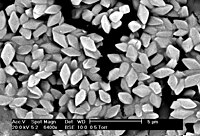
Photo from wikipedia
Abstract The estuarine tapertail anchovy (Coilia nasus) is a small anadromous fish mainly distributed in the northwest and western Pacific, extending southward toward Guangdong in southeastern China and northward to… Click to show full abstract
Abstract The estuarine tapertail anchovy (Coilia nasus) is a small anadromous fish mainly distributed in the northwest and western Pacific, extending southward toward Guangdong in southeastern China and northward to the Ariake Sound of southwestern Japan. This important commercial anchovy has suffered from population decline in both Japan and China, and the taxonomic status of the populations from Japan and China has been disputed. To ascertain the taxonomic status of the populations from Japan (C. nasus) and China (once named C. ectenes), the genetic diversity was comparatively analyzed between Cyt b gene and D-loop sequences of C. nasus from Rokkaku River in Ariake Sound, Japan, and those of C. nasus in waters of China downloaded from GenBank. The results showed that the nucleotide diversity of Cyt b haplotypes of C. nasus from Rokkaku River was 0.0033, and the nucleotide diversity based on D-loop analysis was 0.0061. The level of fixation index (Cyt b: 0.2861/D-loop: 0.2890) between C. nasus from Japan and China were relatively high, and the level of genetic distance (Cyt b: 0.0052 ± 0.0014/D-loop: 0.0168 ± 0.0038) was lower than that between C. nasus and C. mystus. The phylogenetic trees and haplotype network constructed based on Cyt b gene and D-loop sequences indicated that C. nasus populations from Japan and China failed to form monophyletic clades respectively, suggesting that the anchovies from Japan and China should be the same species but from populations that had separated from each other.
Journal Title: Regional Studies in Marine Science
Year Published: 2019
Link to full text (if available)
Share on Social Media: Sign Up to like & get
recommendations!